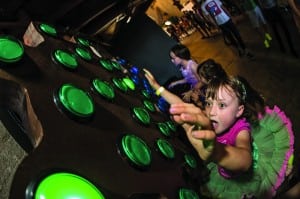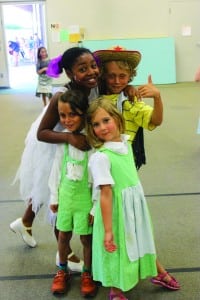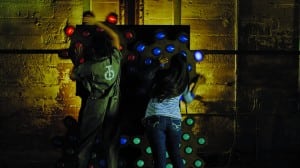Pursuing their passions – or even passing interests – helps kids find their place in the world
By Christina Elston
Once upon a time, my daughter wanted to be a princess. Then she decided to become a ballerina, a herpetologist, part of her school’s marching band, a rock star and a photographer. This means we went to ballet, guitar and clarinet lessons, nature and zoo camps, and photography workshops. Often her father and I were excited to see her pursue a new interest. Sometimes we were frustrated that she kept bouncing from one thing to the next.
But this, it turns out, is just how a child is supposed to operate.
“Our kids need to browse,” says Susan Daniels, Ph.D., co-author of Raising Creative Kids (Great Potential Press, 2013). Just as we try on clothes or test-drive cars, “our children need to test-drive experiences, too,” she explains.
 Encourage Curiosity
Encourage Curiosity
To start, make room for your kids to experiment and pursue whatever draws them in. “Kids are natural explorers and follow their curiosity from the time they are little,” says Melissa Weber Bales, who teaches high school theater at Wildwood School in Los Angeles and has a 17-year-old son and 21-year-old daughter.
The beauty of just dabbling is that there is no expectation your child will produce a masterpiece or become an expert. The pressure’s off. There are many ways to encourage this, but here are two:
Set aside an area in your home as a creation station (L.A.-based child development specialist and author Betsy Brown Braun, Ph.D., calls this a “legal messy area”) stocked with art materials, tools, magnifying glasses, recycled objects such as foil and cardboard, and anything else that might fit. Step back and let your child enjoy.
Give your child a blank artist’s notebook with good paper and unlined pages to use as an “explorer’s journal.” Daniels says this is a place for making notes, drawing pictures, and otherwise recording experiments, lessons learned, and ideas and questions to investigate.
 Launch An Exploration
Launch An Exploration
There are lots of other ways to help your child find and pursue interests. Consider asking your child’s teacher about what activities and topics she or he seems to gravitate toward at school. There might be a campus-based program – either during the school day or after school – that would be a good fit.
You might also consider a separate enrichment program, but make sure the focus is on helping kids explore and enjoy, rather than on perfection. “Eventually, kids start to fall in love with things and want it to be more than just love. They want to be learning skills,” says Bales. But unless you have that rare child (golfer Tiger Woods is an example) who latches onto their life’s calling early, that usually doesn’t happen before the teen years.
Meanwhile, venture out into the world with your family and seek new experiences. “Exposure is such a big part of what can spark interest,” says Jason Porter, assistant director of education at Skirball Cultural Center and a former teacher. “Getting out of the house is always the first step.”
Live experience can be a powerful inspiration. “There’s something about seeing real things, like real musicians playing on real instruments. That’s something that you can’t really capture when you watch it on video,” says Porter, whose 13-year-old daughter was inspired to play viola by her concert-going experiences. The Skirball offers a wealth of family activities – from concerts, to simulated archeological digs, to their Noah’s Ark exhibit with animal puppets and live puppeteers. “Being able to see a puppeteer really work something is so much different than watching the Muppets,” says Porter.
Daniels suggests a few other ways for families to hunt down new interests:
Pick up a local guidebook and visit attractions you haven’t seen before.
Take a class together. You’re exposing your child to something new, and acting as a role model by exploring something yourself.
Attend a Maker Faire (www.makerfaire.com), a family-friendly festival of invention and creativity. There is a Mini Maker Faire tentatively planned for Dec. 7 in San Diego (www.sandiegominimakerfaire.org) and one sponsored by the L.A. County Science Fair in Pasadena March 27-29, 2014 (www.lascifair.org).
“Be willing to take them to anything. Put things in front of them that they haven’t experienced before,” advises David Levine, theater and film teacher at LAUSD’s Sonia Sotomayor School of History and Dramatic Arts. But understand you might need to nudge a bit.
A few years ago, Levine decided to sign himself and his then-13-year-old daughter up to participate in the L.A. Community Opera. At first, she was reluctant and only attended rehearsals grudgingly. “It was really unpleasant for the first week,” he recalls, but eventually his daughter made friends of fellow cast members, and the two of them ended up having a blast.
Porter has had similar experiences with his daughter, who might hesitate when invited to attend a concert where she’s not familiar with the performer or the genre of music, but often enjoys the experience in the end. “Once we get out there, she’s very open to it, and I think a lot of kids are,” he says.
Gather STEAM
You might consider all this effort a way to lure your children away from the various screens that seem to have such a hold on their attention, and some limiting of “screen time” is reasonable. “It kind of becomes a comfort zone of entertainment, all these screens,” says Bales. Still, some of what kids are doing on these screens can be a creative resource and tool. “Within reason, it’s fine. It’s part of their world,” she says.
Engineer and computer scientist Brent Bushnell even calls high-tech games a “Trojan horse for getting kids excited about engineering.” Bushnell points out that in video games, the instruction manual is embedded in the game, forcing players to problem-solve just to play.
Building on the STEAM (Science, Technology, Engineering, Art and Mathematics) education trend, Bushnell and his partners at technology amusement company Two Bit Circus are launching what they call STEAM Carnivals. These events – the first of which is happening in L.A. this spring – include a carnival full of technology-based games, and showcase creations kids have made with kits they can pre-order online. There will be a concert from musical robots and a fashion show featuring wearable electronics, all made by teens and tweens. “We wanted to really make this exciting and fun, and not just another science fair with baking-soda volcanoes,” Bushnell says.
Get a taste of what they have planned by visiting the Two Bit Circus Downtown L.A. studios during the Brewery Art Walk, 11 a.m.-6 p.m. Oct. 12 and 13 (www.BreweryArtWalk.com), or visit www.STEAMCarnival.com. Bushell also recommends these STEAM-based games and toys for kids:
Scratch, from MIT (www.scratch.mit.edu): This online learning community offers free tools that let visitors program and share interactive stories, games and animation.
DragonBox (www.DragonBoxapp.com): This multi-platform game secretly teaches algebra to your children.
Goldie Blox (www.GoldieBlox.com): This book series and construction toy teaches engineering skills to girls.
Another fun option is Kids Can Code (www.KidsCanCode.org), which offers classes that let children look “under the hood” of their computer, laying the foundation for a relationship with technology. L.A. dad Chris Bradfield launched the company with his wife, Priya, after a stint volunteering to teach computing at his daughter’s elementary school. Bradfield himself fell in love with computers at an early age. “My middle school had a bunch of TRS-80s where we could learn BASIC, and we were quick to use them to start making our own computer games, which was the only way to get to play at that time,” he says.
 Fickle Is Fine
Fickle Is Fine
Just remember that whatever your child’s love at the moment, there is a good chance that devotion will fade over time. And that’s OK.
Brown Braun has seen parents hoping to turn their child into college material push them toward declaring a lifelong passion during elementary school, which she believes is a mistake. “It’s so limiting, and this is not the time to limit a child,” she says. “This is when the world is his oyster.” Young children should feel free to dream of being a professional athlete and a firefighter and president of the United States – all at once, declares Brown Braun.
Be ready for this fickleness, and give your child a chance to really try out a new interest before investing in expensive equipment, months of classes or a private coach. If you have invested and you see your child losing interest, have a conversation and strike a deal. “Because you paid for something should not be the reason that a child has to do it,” says Brown Braun, but there’s also value in encouraging your child to finish what she or he starts. A compromise could be that your child finishes this science camp or softball season, but doesn’t have to go again, or that she help post that clarinet on eBay.
These pursuits – even if they don’t lead to a college scholarship or career – are never wasted.
Levine points out that trends in education are shifting toward a model called Common Core, where there is a heavy focus on building thinking skills that transfer easily from one subject area to another, and from one job to another. “Those are the types of skills that the arts and athletics and extracurricular activities give you,” he says.
Beyond that, these pursuits help turn child explorers into well-rounded adults. Because even if you aren’t an astronomer, it’s nice to look up at the night sky and be able to find the constellations. Says Bales, “I really think it’s about meaning in our lives as human beings.”
Christina Elston is editor of L.A. Parent.


























